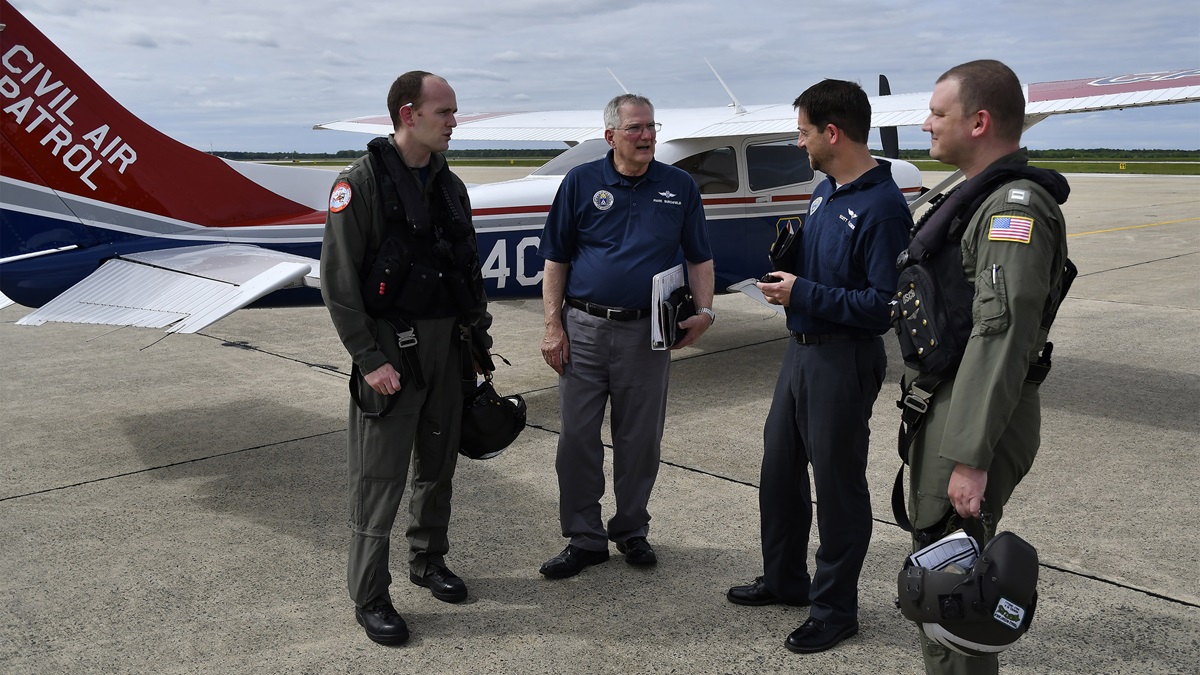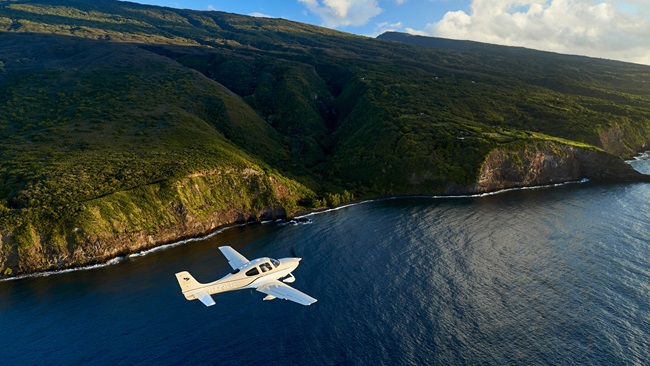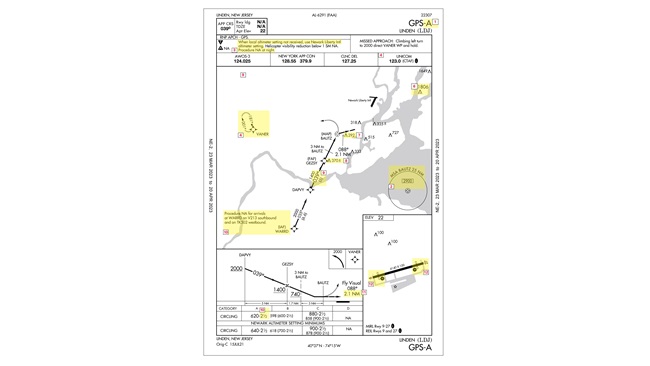Joint military CrossTell exercise eyes TFRs
NORAD, Coast Guard, Civil Air Patrol join forces
Wisps of puffy clouds floated by the Cessna 182 and pleasure boats dotted the waterways near Atlantic City, New Jersey, as the shoreline came into view on an afternoon sight-seeing trip. A storybook view from the pilot’s seat of a general aviation aircraft was the perfect way to spend a lazy weekday. Then, a large, menacing-looking orange helicopter swooped into formation, tucking in tightly under the ambling aircraft’s left wing, shattering the serenity and shaking the pilots.
“Aircraft this is the U.S. Coast Guard on 121.5, you have been intercepted. If you read me, acknowledge this transmission and rock your wings.”
The Coast Guard’s mission changed from a warning to an escort as the situation escalated because the unresponsive aircraft was conceived as a threat to national security and flying in a temporary flight restriction (TFR). “Coast Guard helicopter, Charlie Papa 644, we do hear and see you,” replied the shaken Cessna pilot.
Fortunately, in this case, the wayward “rabbit” was a Civil Air Patrol (CAP) aircraft simulating an airspace intruder near the Bedminster, New Jersey, TFR that hovers over one of President Donald Trump’s properties. Pilots Scott Faulkner and Mark Burchfield were taking part in a joint CrossTell Exercise mission performed by the North American Aerospace Defense Command (NORAD), the U.S. Coast Guard, and the CAP.
The playbook indicated the pilots could now acknowledge and comply with the command by rocking their wings and communicating over the VHF guard frequency of 121.5 MHz, as instructed. The Cessna pilot began a right turn and acknowledged, “We are turning to heading 1-5-0 for November 644 Charlie Papa.”
“November 644 Charlie Papa, request that you continue your turn to heading 3-0-0. We are going direct to Woodbine Airport for landing,” advised Zombie One, the ominous call sign for the Coast Guard chopper. With communication established and instructions received, the immediate threat was mitigated as the Cessna turned with the Dolphin to exit the area.
Maj. Andrew Scott, a Continental U.S. NORAD Region CONR public affairs officer, explained that preventing a potential TFR violation was preferred to scrambling fighters and helicopters. “We’re not trying to intercept people—that’s not our goal. The goal is to educate and inform the GA community.”
Scott said that TFRs can “catch local pilots off guard” because “they are familiar with the area, they know the landmarks and they know where they can and can’t go, but all of that changes after a TFR pops up.” He said education is a key “because if we can educate and inform them and stop them [from violating airspace] beforehand, it’s always better.”
The Cessna interception was scary enough with a Coast Guard helicopter traveling at 80 knots, but it would have been downright frightening to be next to a single-seat fighter aircraft with its pilot commanding full armament and orders to stop an intruder at all costs.
TFR violations can be avoided with routine preflight planning, explained U.S. Air Force Col. Bradford Everman, the operations group commander for the New Jersey Air National Guard’s 177th Fighter Wing taking part in the exercise. The Egg Harbor Township-based fighter wing launched crews to defend the nation immediately after the Sept. 11, 2001, terrorist attacks in New York City; Washington, D.C.; and Pennsylvania. It also has taken active roles in Operation Noble Eagle, Southern Watch, Northern Watch, Iraqi Freedom, and Enduring Freedom. When he is not behind the controls of an F-16C, Everman is a GA pilot who sometimes unwinds by flying a Cirrus SR22 or a Diamond DA40 “for fun.”
“Nothing makes us happier,” Everman confided, “than not having to come out and work with you doing our primary job of defending the United States airspace." He said, “the basics are pretty obvious” and advised pilots to “check the notams and check the temporary flight restrictions” in addition to performing preflight diligence for weather and other flight conditions. He said that pilots who maintain awareness about news events and expected VIP travel can help keep themselves out of the news.
“When you check your TFRs, the biggest thing you [can] do is know what is going on around you. One thing that’s not that obvious, but I’ll throw it out to you, is if you know the president is traveling or other high-ranking government officials are traveling because you follow the news, there’s likely a TFR that will follow those individuals.” He warned that if there’s a planned VIP event, “you can plan on there being fighters close by.”
GA pilots frequently quiz him on what to do if they are confronted by a fighter after violating restricted airspace. “Believe it or not that is the most common question,” so he suggested a mitigation strategy that pilots should commit to memory to avoid an F-16 Fighting Falcon on their tail.
“The absolute first thing that you do is acknowledge the presence of the fighter. The best thing that you can do is make sure that person—flying that airplane—knows that you see them and that you are aware that they are there. If that happens, it deescalates that entire situation because we have now agreed” that the two parties have acknowledged each other. After that first step, “Half the problem has already been reduced, so, flash your lights, smile if you have to, even take a picture of me,” Everman joked. He clarified that the official response was to “rock your wings” to prevent any communication issues.
Everman said it was equally important for pilots to monitor the 121.5 MHz guard frequency because “in the middle of the intercept we will be trying to reach you on 121.5. So, to the maximum extent that you can, have that frequency up and be monitoring it” during routine flight. Then simply “follow the directions you receive on the radio, or visually, from the aircraft.” Sometimes intercepting aircraft crew hold up signs or other devices.
For those who violate a TFR, Scott was purposefully ambiguous when pressed as to whether an Air Force F-16 or a Coast Guard MH-65 would be called into duty. “Every scenario is different,” he explained, depending on the threat level, the aircraft involved, and the proximity from military air support. He said that pilots flying near TFRs might not be aware of it, but crews are likely monitoring their behavior from other locations—or from other aircraft.
To raise awareness, Scott said, the 601st Air Operations Center’s GA outreach program includes posters, kneeboards, and letters written to local fixed-base operators, asking them to remind aviators of TFRs and post enclosed materials in public flight planning areas. In conjunction with efforts by the 601st, the CAP visits airports to speak face to face with pilots, reminding them to “check notams and fly informed.”
Scott emphasized that it is particularly important to advise the GA flying public in light of the president’s frequent winter trips to Lantana, Florida, or his summertime visits to Bedminster. “Anything we can do to get the word out for Bedminster is a win-win," Scott said.
















